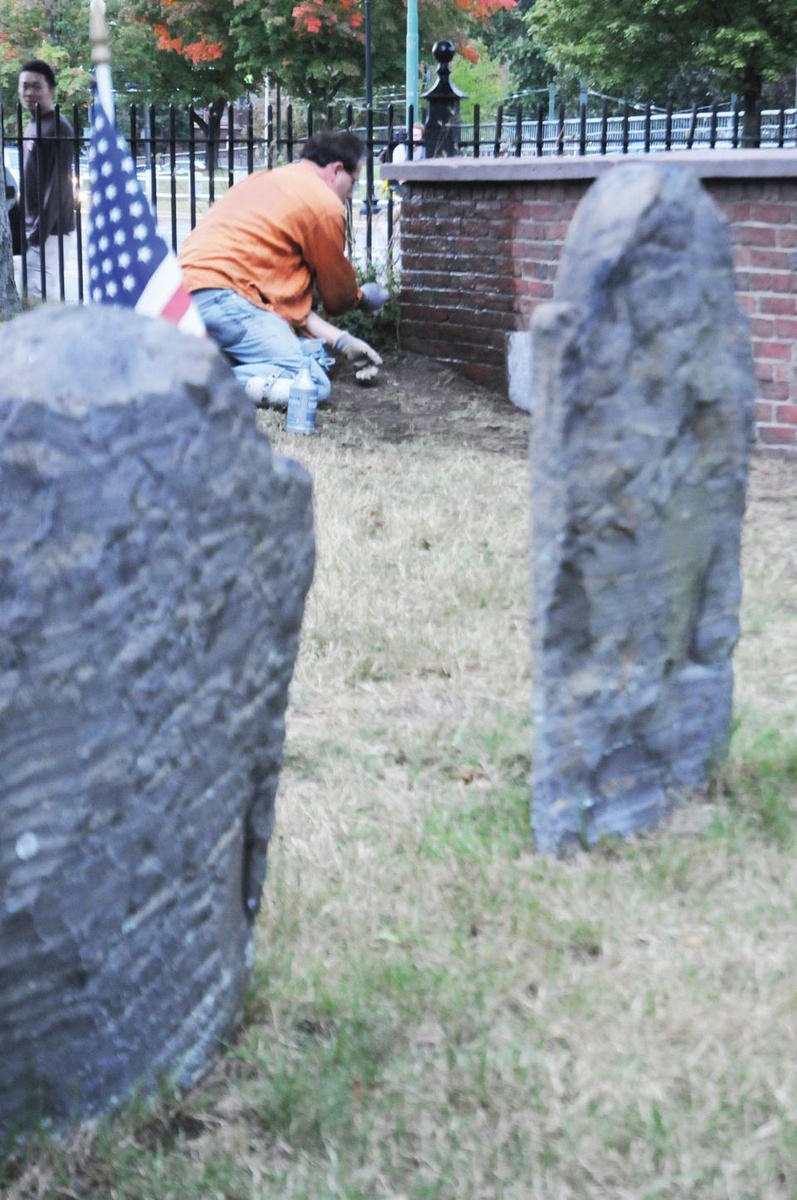The singing man dressed in a colorful parka who is often on his knees scrubbing graves in Cambridge’s Old Burying Ground often elicits confusion in Quad students walking to and from class. But Dario Fiorentini’s enthusiastic abandon is due to his passion for his work as a conservator.
“This job becomes like a second skin,” he says. “It’s inside you.”
The city hired Fiorentini, a Roman-born conservator, to restore the sixteen table tombs—gravestones that either lie horizontally on the ground or are supported by four legs—in Cambridge’s oldest cemetery. He brings an artistic sensibility and creative spirit to his work, which can sometimes be laborious or mechanical.
Fiorentini has a deep respect for history and artifact, a quality he considers important for his work. Indeed, the somber Old Burying Ground, lodged in the bustling city—between two historic churches and an upscale pizzeria—is saturated with narratives of Cambridge’s past.
A PLOT OF HISTORY
The Old Burying Ground has been used as a graveyard in Cambridge since at least 1635, just four years after the city’s founding, and one year before the founding of Harvard College. Revolutionary War veterans are buried there, including two black soldiers, as well as the early presidents of the College. These early presidents include Harvard’s first president Henry Dunster, as well as Charles Chauncy, Benjamin Wadsworth, class of 1690, Edward Holyoke, class of 1705, Joseph Willard, class of 1765, and Samuel Webber, class of 1784, according to Samuel A. Eliot’s “A History of Cambridge, Massachussetts 1630-1913.”
Even though the land has long been home to such illustrious corpses, Eliot suggests that “it seems not to have been very carefully guarded.” He points to evidence that it was used as a sheep pasture until 1702.
Grazing sheep have been replaced with ambling tourists, strolling in between the graves and searching for a flavor of Cambridge’s history. Yet, Fiorentini complains that the sacred ground is ill-treated by some of the graveyard’s current visitors. He notes that when he comes to work, he sometimes finds Smirnoff liquor bottles or cans of Bud Light littering the cemetery, or even uprooted gravestones on occasion.
“They use this as a playground,” he says. “They have to pick up their trash.” “They drink,” he adds with a compassionate and understanding tone. “But they have a very bad habit.”
Unlike in years past, the front gate to the cemetery is now chained and locked to discourage such misuse of the space; but the chain has been broken many times.
“This is not acceptable” Fiorentini says, shaking his head sadly. “This place needs to be taken care of more often.”
“TREATING” THE GRAVES
Fiorentini’s care and concern for his work is apparent in his meticulous, almost clinical “treatment” of the graves.
“You have to respect the place where you work,” he says. “Every time you do some work you need to know the stone, what it needs. You try to do a treatment so that you will save the piece for the next generation, to preserve it.”
Fiorentini has developed a complex restoration process. Before he start cleaning a piece of a gravestone, he injects it with resin to stabilize it. Then after a few days he cleans the piece “section by section, without removing anything.” Next he begins to repair and fill any damage with the appropriate kind of mortar. After that comes the final measure, which Fiorentini calls “consolidation.” He describes this ultimate step as the one that looks towards the future.
Read more in News
Baer Emphasizes Narrative













